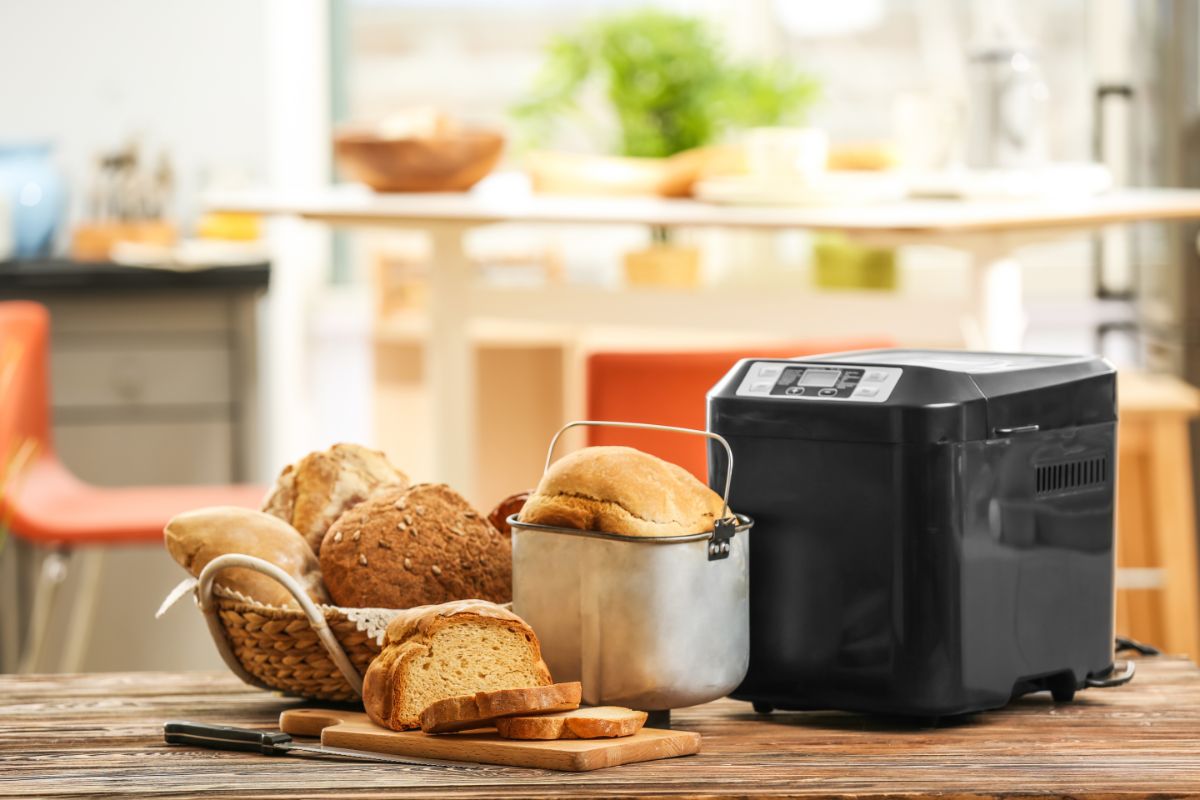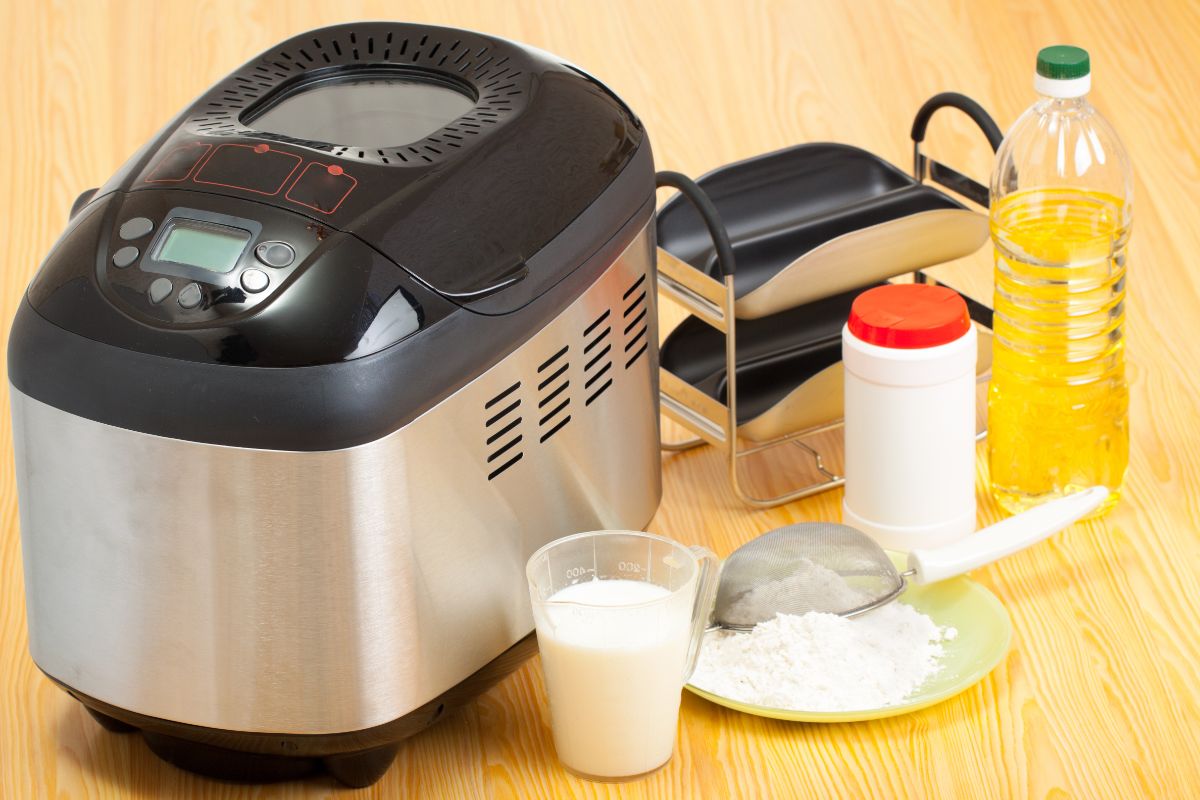Most bread machines bake bread at 350 degrees Fahrenheit or 175 degrees Celsius.

Doughs with richer ingredients like butter and eggs will bake at 350 to 375 degrees Fahrenheit. This dough will be done when it cooks all the way through at 180 to 190 degrees Fahrenheit or 82 to 88 degrees Celsius.
The most whole-grain dough will be baked at 350 to 375 degrees Fahrenheit. Some “leaner” doughs will bake at 400 degrees Fahrenheit. The lean dough will be done when it is between 190 to 210 degrees Fahrenheit or 88 to 99 degrees Celsius.
When the interior is kept at this temperature long enough, you’ll get bread that is thoroughly cooked. It will be moist and fluffy, not gummy. Monitor the temperature of the inside of the loaf to ensure that it is thoroughly cooked. This becomes more important as the size of the loaf increases.
Check the recipe when making the dough to determine the right temperature for the bread machine if it doesn’t have a thermal profile for that type of bread. This is at least a starting point for choosing the right baking temperature for your bread.
*This article may contain affiliate links. As an Amazon Associate, I earn from qualifying purchases. Please take that into account.
- Dutch oven
- Large mixing bowl
- Measuring cups and spoons
- Bread thermometer (fancy or a budget one)
- Scoring lame
Extra (nice to have):
- Kitchen scale
- Dough scraper and bowl scraper (yes, they are different)
- Cooling rack
- Baking stone (you don’t need a dutch oven if you use this)
👉Learn how to make bread and pizza with this awesome book.
What other temperatures do bread machines bake at?
Bread containing eggs and dairy products must be baked at a high enough temperature to kill any potential bacteria. If your bread is literally a mixture of water, flour and other vegan products, you could in theory bake bread at 140 degrees Celsius for the first two hours and 170 degrees Celsius for the last 20 minutes.
Use a lid that won’t let heat leak out, and it could bake as low as 150 degrees Celsius for the first twenty minutes and 140 degrees Celsius for the final hour and fifteen minutes.
However, the bread must get to 95 degrees Celsius inside to be safe to eat. You can verify this with a needle thermometer, taking care not to touch the baking pan.
When are other temperature settings used in bread machines?
Yeast is best proofed with warm water, provided it isn’t too hot. The ideal temperature is 105 to 110 degrees Fahrenheit. At 95 degrees Fahrenheit, you have the best temperature for multiplying yeast but not getting active dry yeast to dissolve and activate. However, people rarely proof yeast in the bread machine.
Yet they often use the bread machine to maintain and nurture a “starter”. For example, a sourdough starter contains both yeast and lactobacilli. The bread machine keeps it at the right temperature while protecting it from the air. This prevents the temperature from getting above 140 degrees F or 60 degrees Celsius; that will kill the yeast.
You can also use a bread machine to make yogurt. Not every bread machine has the right temperature profile for this. The best temperature profile here is 110 degrees to 115 degrees Fahrenheit. Like sourdough, you’ll need a starter culture. And like yeast, you’ll kill it if you get it too hot.
What other times might you want to use the bread maker to keep things warm?

Bread makers can be used to make the dough and then foster its rapid rise before you put it in the oven. Your bread maker should have a setting for simply making the dough, whether it is pizza dough, bread dough or cinnamon rolls.
Advanced bread makers can keep the dough at the ideal temperature for up to 13 hours before it starts to bake, allowing you to have fresh bread ready right before you want to serve it.
However, you can’t do this with dough that contains fresh milk or eggs. Some bread makers can serve as bread warmers just like the warming drawer under your oven. You can get the same benefit by letting the bread cool in the bread maker after you’ve removed it from the baking tray.
Leave the lid open just a crack so that the cooler outside air can reach the bread without drying it out or causing cracking on the surface.
Why might a bread maker fail to properly cook bread?
If you’re constantly opening the lid to check on the bread, you’re letting out heat. The bread maker may not be smart enough to add time to the clock to offset that. Leaving the lid off results in bread that doesn’t get as hot as it should.
Adding cold milk and butter may prevent the dough from getting as hot as quickly as expected, resulting in an under-done loaf. You’ll certainly undermine the machine’s performance by adding frozen flour; even smart bread makers will fail to recognize that frozen dough mixed with other ingredients isn’t warm enough.
You can minimize these problems by adding room temperature dry ingredients and, ideally, warm water, milk, and eggs while the machine gets to work. Having the wet ingredients at 100 degrees F or higher will not hurt the end product, regardless of what baking mode you use. You may also see less than desirable results if you mix water and yeast too early.
If the bread maker is working properly but doesn’t seem to be fully cooking the bread, you can try moving the bread maker to a warmer room.
If that doesn’t help, the unit may have a bad heating element. Or you really need to clean the baking pan, because the baked on grime is acting as insulation, preventing the new bread from cooking properly. Dough that contains too much liquid won’t get fully cooked, either.
Another possibility is that you’re adding too much to the bread pan. That’s often the case if the bottom is done but the top is undercooked. Be careful with the capacity.
A thermal profile to cook at 2 pound loaf of bread may undercook at 1 pound dough ball. In the reverse situation, you’ll burn the bread. If the dough is over-proofed, demonstrated by doubling or more, you could get bread that burns, too.
On the flip side, if there is not enough space at the top of the bread bucket, there won’t be room for hot air to circulate, cooking the top of the loaf.
You could also get soggy bread if you slice up the loaf too soon instead of letting it cool first.
